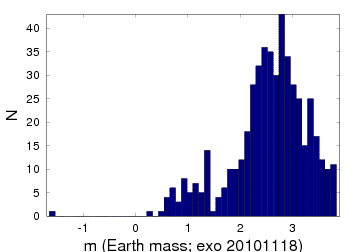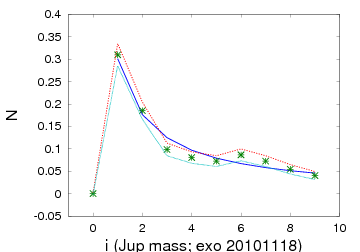You are here: Foswiki>Cosmo Web>MediaShapeUniverse>ExoplanetBL (19 Nov 2010, BoudRoukema)Edit Attach
<< Cosmo
short URL: http://cosmo.astro.umk.pl/Cosmo/ExoplanetBL
Exoplanets and Sambridge et al.
Disclaimer: This is just an instant, superficial, analysis, not a serious, well thought-through analysis. A very rough quick analysis of Jean Schneider's Exoplanet database planetary mass distribution downloaded 2010-11-18, in response to request for an ultra-rapid comment on Sambridge et al. 2010, "Benford's Law in the natural Sciences", Geophysical Research Letters, 37, L22301, which seems to be an extension of Sambridge et al. 2009, http://cdsads.u-strasbg.fr/abs/2009AGUFM.S33A1756S . There are 497 exoplanets in the list downloaded 2010-11-18, while Sambridge et al. 2010 had a list of 401 exoplanets from the same source, downloaded at some earlier date.rapid plots
Logarithmic binned distributions of masses, either in units of a Jupiter mass or of an Earth mass.- histJ.png:

- histE.png:

- benJ.png:

- benE.png:

physical studies
- Sambridge's "detection" (which they do not claim is significant) of somewhat more 6's than BL would seem to be qualitatively consistent with e.g. Mordasini et al. ArXiv:0904.2542 who tested a planetary population model using just 32 observed planets. See Fig 2a, Fig 3, ArXiv:0904.2542 and compare to the above.
instant summary
The present population of all detected exoplanets seems to consist of several narrow distributions, partly due to:- the use of several different methods (mostly radial velocities, transit, microlensing so far), which do not yet have much dynamic range, since the higher mass exoplanets are (usually) easier to detect for any given method; that is, each method gives a narrow log-distribution in masses
- intrinsic distributions that have some narrow features in log(mass) - see e.g. Mordasini et al
- most of the exoplanets (radial velocity detections) are M sin i estimates
- "Exoplanet masses can be difficult to estimate"
| I | Attachment | Action | Size | Date | Who | Comment |
|---|---|---|---|---|---|---|
| |
benE.png | manage | 14 K | 19 Nov 2010 - 10:52 | BoudRoukema | |
| |
benJ.png | manage | 14 K | 19 Nov 2010 - 10:52 | BoudRoukema | |
| |
histE.png | manage | 13 K | 19 Nov 2010 - 10:52 | BoudRoukema | |
| |
histJ.png | manage | 13 K | 19 Nov 2010 - 10:52 | BoudRoukema |
Edit | Attach | Print version | History: r1 | Backlinks | View wiki text | More topic actions
Topic revision: r1 - 19 Nov 2010, BoudRoukema
 Copyright © by the contributing authors. All material on this collaboration platform is the property of the contributing authors.
Copyright © by the contributing authors. All material on this collaboration platform is the property of the contributing authors. Ideas, requests, problems regarding Foswiki? Send feedback


